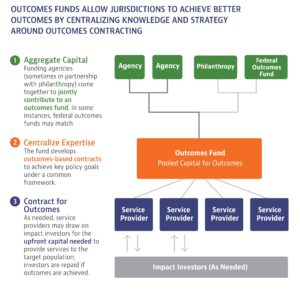Key Highlights
Challenges
Solutions to complex social issues often require government agencies to work together. But interagency cooperation can be cumbersome and slow. To give one example, a workforce program for veterans with post-traumatic stress disorder was found to be effective, but it took four years to launch — requiring coordination among the U.S. Department of Veterans Affairs, the Commonwealth of Massachusetts, and the cities of Boston and New York.
Opportunities
Outcomes funds provide communities with the flexibility needed to imagine big ideas and original strategies, encouraging and facilitating cooperation. It also maximizes the impact of every government dollar spent. By identifying a set of priority target populations, setting a clear outcomes target, obtaining outcomes-funding from relevant agencies, and paying only for the achievement of the target outcomes, outcomes funds provide an effective model for creating impact.

Findings and Next Steps
- Outcomes-based funding ensures policymakers pay only for what works, maximizing the efficiency of funds.
- With practice, this approach becomes faster and more cost-efficient, attracting philanthropic and corporate support.
- As the federal government leads by example, states should follow by prioritizing outcomes-focused programs in grantmaking.

